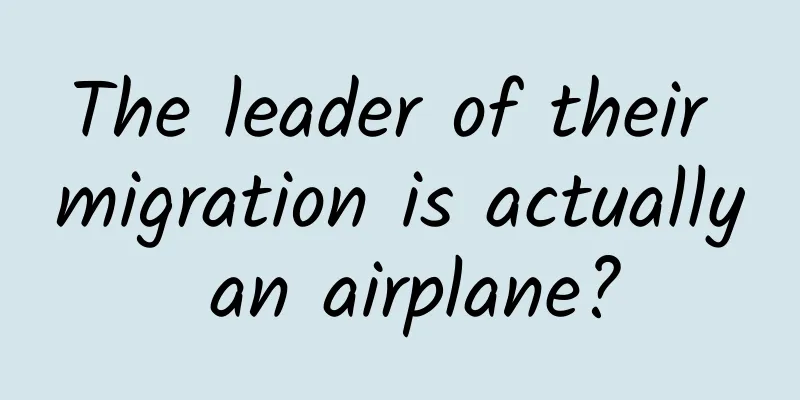The leader of their migration is actually an airplane?

|
Right now, an incredible feat is taking place in the skies over Europe - four humans, flying two paragliders, are heading south with a flock of migrating birds . But don’t birds migrate on their own? Why do they need humans to lead the way? Will they really follow humans? On August 21, the migration group set off|Waldrappteam / Facebook ▲Flying an airplane to guide bird migration The birds being carried by the plane are called Hermit Ibis (Geronticus eremita). Twenty years ago, zoologists flew them on planes to migrate - because their situation in the wild was already precarious. The Hidden Ibis, also known as the Northern Bald Ibis, lives in groups in deserts, semi-deserts or rocky environments. It is a relative of the same family as the Crested Ibis . The Hidden Ibis was once widely distributed in the Middle East, North Africa and Southern Europe. However, in modern times, due to overgrazing and hunting, the number of Hidden Ibis in the wild has dropped sharply . In 1990, the Hidden Ibis was listed as a critically endangered species , and most Hidden Ibis are now being raised in zoos. I still had hair when I was a kid, but my hairline moved back as I grew older|Waldappteam / Facebook Animal behaviorist Johannes Fritz wants to change the situation of the ibises and restore more wild populations. Fritz founded the Waldrappteam, and since 2004, they have been trying to fly young ibises to the wild for wintering . These young birds are collected from various zoos, and they will raise the birds from hatching to full feathers in autumn, and then return them to the wild. Every year, the team leads the ibis from its spring breeding grounds in the northern Alps and flies south to its wintering area , the Lake Orbetello Nature Reserve in southern Tuscany, Italy, where the ibis is released. The locations of the breeding and wintering areas. The red lines are the migration routes|Waldappteam / Facebook When the ibis reaches sexual maturity at the age of three, most of the released birds return to their habitats in the spring to breed . In the fall, they continue to fly high, and those with children lead their children to migrate south, and the cycle repeats. Once the migration tradition is formed, human intervention is no longer needed . Wife, kids, warm bed, rock wall|Waldappteam / Facebook In the spring of 2011, the team observed the first independent migration of the Hidden Ibis back to the north. It started from the wintering area in Tuscany and successfully flew back to the breeding area along the route it had previously used. In the following years, more and more Hidden Ibis migrated along this route on their own. So far, more than 270 Hidden Ibis have been traveling back and forth on this route steadily. In 2018, the Hidden Ibis was downgraded from critically endangered to endangered . However, due to climate change, this migration route that was established with great difficulty has become difficult again. ▲Challenges brought by climate change To survive the European winter, the ibis need to get south before the Alps become extremely cold . Last year, when Fritz monitored the wild ibis, he found that the birds' feathers were covered with snow, and their long beaks were struggling to find worms in the frosty soil. In 2022, only 5 of the 60 ibis that spent the summer in the breeding grounds successfully crossed the snow-capped mountains and returned to the south . Under the influence of climate change, the warming autumn has delayed the start of their migration. Ten years ago, they would usually set out at the end of September, but now it has been delayed to the end of October . However, the later they start migrating, the more difficulties they may encounter - in November, the rising warm air currents in the Alps are too weak , and the ibis will find it difficult to fly over the mountains, and will be trapped in the icy Death Valley. If this continues, the wild population that has gradually recovered with great difficulty may become extinct again . The ibis needs to fly over the Alps to spend the winter safely. | Gzzz/Wikimedia Commons To save these failed migration ibises, Fritz and his team lured the hungry birds with mealworms, loaded them into cars, drove around the steep mountains , and sent the ibises to the southern Alps. But they also realized that this was not a sustainable solution. The ibises could not always rely on trucks for transportation, and eventually they had to migrate on their own . Therefore, for this year's migration, Fritz came up with an idea - to show the ibises a new migration route . Tell me about it? |Waldappteam / Facebook The new route planned by Fritz starts from Binningen in Germany and goes southwest, bypassing the Alps to reach another suitable wintering ground, the Andalusia region in southern Spain. However, this new wintering ground is 2,300 kilometers away from the breeding ground , more than three times the previous migration distance. Therefore, this year's wintering migration is a challenge for Fritz's team and the ibis. Comparison of the new migration route and the original migration route|Waldappteam / Facebook ▲Preparing for flight Whether it is the ibises or other birds, they will not follow airplanes and people for no reason. If you want the birds to join and follow the flight, you need a lot of preliminary training and preparation . Over the past decade, the Waldrapp team has also continuously optimized the breeding process of the ibises, improved aircraft equipment and flight technology. This year, Helena Wehner and Barbara Steininger are acting as human foster mothers , caring for the ibis chicks at the breeding site and accompanying them as they grow up. Only foster mothers can have contact with the birds, which helps the chicks form a kind of "parental imprinting" . Accompanying the baby ibis born in April this year to grow up|Waldappteam / Facebook The two foster mothers constantly and closely interact with each bird, and the bond between the bird and the foster mother is further consolidated and strengthened. This strong "social bond" is the basis for flying together, ensuring that the bird can follow the foster mother for hundreds or thousands of kilometers during migration. In order to reduce the birds' fear of airplanes, the foster mothers will regularly play engine sounds to them before they come into contact with the aircraft; airplanes will also fly up and down in front of the aviary, so that the hermit cranes can gradually adapt to the aircraft without any pressure. After the chicks hatch, they will begin to grow feathers after 42-50 days. When the feathers are fully grown, the birds will officially enter flight training camp . The propellers of the aircraft are surrounded by mesh cages to prevent birds from being accidentally injured by the propellers during flight|Waldrappteam The aircraft will fly at a speed of 40-45 km/h, the same as the normal flying speed of the ibis. During the initial flight training, the daily flight distance is about 60 km; after the ibis gradually adapts, it can fly up to 300 km a day. The foster mother will keep calling the birds to encourage them to follow | Waldrappteam The official migration flight formation has two planes , piloted by Fritz and another experienced pilot, with a foster mother in each back seat . The car team will also accompany the flight formation, and they keep in touch via radio. This year's migration is expected to take 30-40 days, and there will be a rest day after departure. The ground team will dismantle the camp after each takeoff, and quickly build a birdhouse after arriving at the next resting place for the ibises to rest. Another plane's view | Waldappteam / Facebook After arriving at the wintering area, the birds will live in the aviary for a few weeks. After that, they will be separated from the care of their foster mothers, adapt to the new environment, come into contact with wild conspecifics, and integrate into the local group . The team will also equip the birds with positioning devices before releasing them to facilitate tracking and monitoring of their migration status in the future. You can also follow the migration dynamics in 2023 on the official website of the waldapp team|https://www.waldrappteam.at/en/migration-current/ ▲This is not the first time that humans have taken birds flying By the way, how did Fritz come up with the idea of using a small plane to guide the hermit ibis? In fact, this is not the first time that someone has taken birds to fly , and Fritz was inspired by a successful case. In the 1990s, Bill Lishman took a small group of Canada geese (commonly known as Canada geese) from Ontario, Canada to Virginia, USA. Bill Leishman and his "geese"|Canadian Geographic In the mid-1980s, Leishman learned that chicks imprint on the first thing they see after hatching, thinking it was their parents . So he came up with the idea of flying with birds. He hatched chicks on his farm and trained them to imprint on him, his family, and the sound of the engine, dreaming that the geese would grow up to follow him . Since the Canada geese were born, Leishman has been with them all the time, taking them running on the lawn and making them familiar with the sound of the engine | Documentary "C'mon Geese" Leishman's attempts failed many times. He often crashed into cornfields while flying, and the geese often stayed in the pond and did not join his flight. He spent a long time modifying the aircraft and training the birds. His efforts paid off. One day in 1988, the black geese he raised with great care finally followed their "father" to fly in the sky . "Since I was a kid, I wanted to fly like a bird. I think this is a common wish of many children."|Carmen Lishman Leishman was later called " Goose Father ", and his feat was adapted into a movie. In the popular movie "Fly High with You" , a little girl raised a group of Canadian black goose chicks and flew a plane to lead the birds to their wintering grounds. Warm and touching scenes in the movie|The movie "Fly High with You" Leishman is actually a sculptor by profession. After experiencing flying with geese, he further devoted himself to the conservation of the migration of whooping cranes . More than ten years later, his flight also inspired Fritz, who wanted to save the black ibis . Fritz also successfully guided the migration of the black ibis and restored the wild population of the black ibis by flying an airplane. From escorting 10 young ibises in the past to 35 this year, and from 600 kilometers to 2,300 kilometers, this year's wintering journey is undoubtedly lively and challenging. Now, the migration group has successfully flown more than 670 kilometers and arrived in southern France. I believe that good news will continue to come from afar . References [1] https://www.waldrapp.eu/en/ [2] https://www.waldrappteam.at/en/ [3] https://www.ilpost.it/2023/05/03/ibis-eremiti-cambiamento-climatico-spagna/ [4]https://e360.yale.edu/features/after-a-400-year-absence-waldrapp-rare-ibis-returns-to-european-skies [5]https://www.cabinetmagazine.org/issues/11/harris_lishman.php [6]https://www.cbc.ca/radio/asithappens/as-it-happens-wednesday-edition-1.4471382/remembering-artist-bill-lishman-the-man-who-flew-with-canadian-geese-1.4471389 Author: Bowl Editor: Mai Mai |
Recommend
Super detailed! Summary of the process and methods of building user portraits from 0 to 1
As a design tool, user portraits can help designe...
Samsung, LG and other Korean battery manufacturers increase investment in China: targeting the new energy vehicle industry
According to BusinessKorea Beijing time on May 5,...
"New Year Customs" collect five blessings, and briefly analyze the marketing techniques of Alipay!
• Introduction• As the saying goes, brands levera...
Skim milk vs. whole milk, which one is healthier? It turns out that many people are not drinking it right
During festivals and gatherings with friends Many...
FF mass-produced cars to save LeEco from car crisis: money is the most critical issue
LeEco, which is at the center of controversy due ...
How to implement marketing and advertising strategies?
There was once an ultimate question popular in th...
Hidden in the dusty archives, the scientist who invented the best-selling breast cancer drug
In the process of scientific development, the con...
3 chimpanzees kidnapped, killed if no ransom is paid|Nature Trumpet
Welcome to the 18th issue of the Nature Trumpet c...
Tencent's internal test is exposed, is the hand-swipe payment coming? Industry experts: The application prospects are not optimistic
"If you can pay by swiping your palm, you wi...
Morgan Stanley: Research shows that Chinese companies account for 63% of the global humanoid robot industry chain
Morgan Stanley recently released "Humanoid R...
Kuaishou advertising, Kuaishou advertising account opening
What is Kuaishou Advertising ? Kuaishou is a well...
How much does it cost to customize the Zhuzhou Electrician Mini Program? What is the price of customizing Zhuzhou Electrician Mini Program?
There is no fixed price for the customization of ...
Talk about user cognitive cost!
Let me first explain the general logic. Professor...
Driverless cars come up with new black technology: cars stop when pedestrians wave
Researchers have developed a driverless car syste...
What do I think of “Mimeng” and her articles that keep appearing on my screen?
1. Two weeks ago, I encountered an interesting th...









